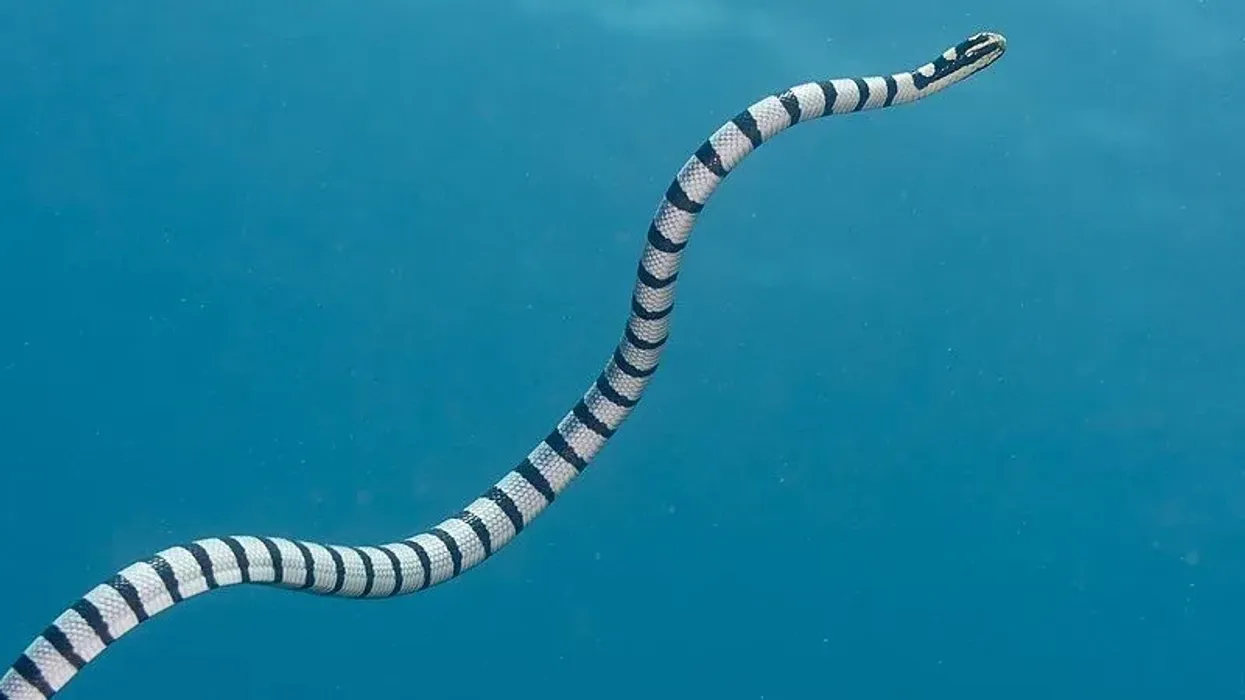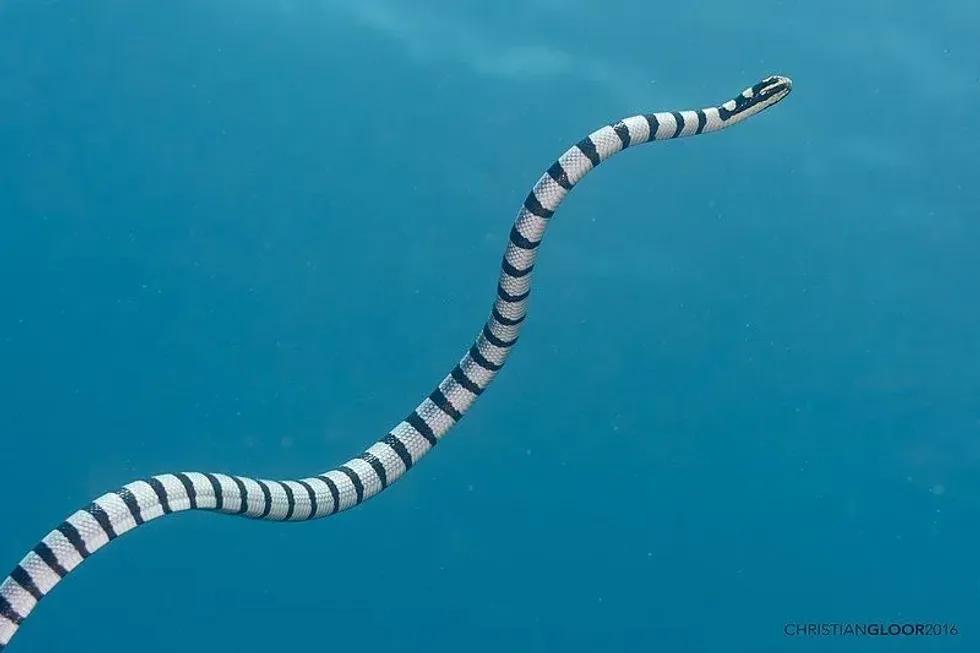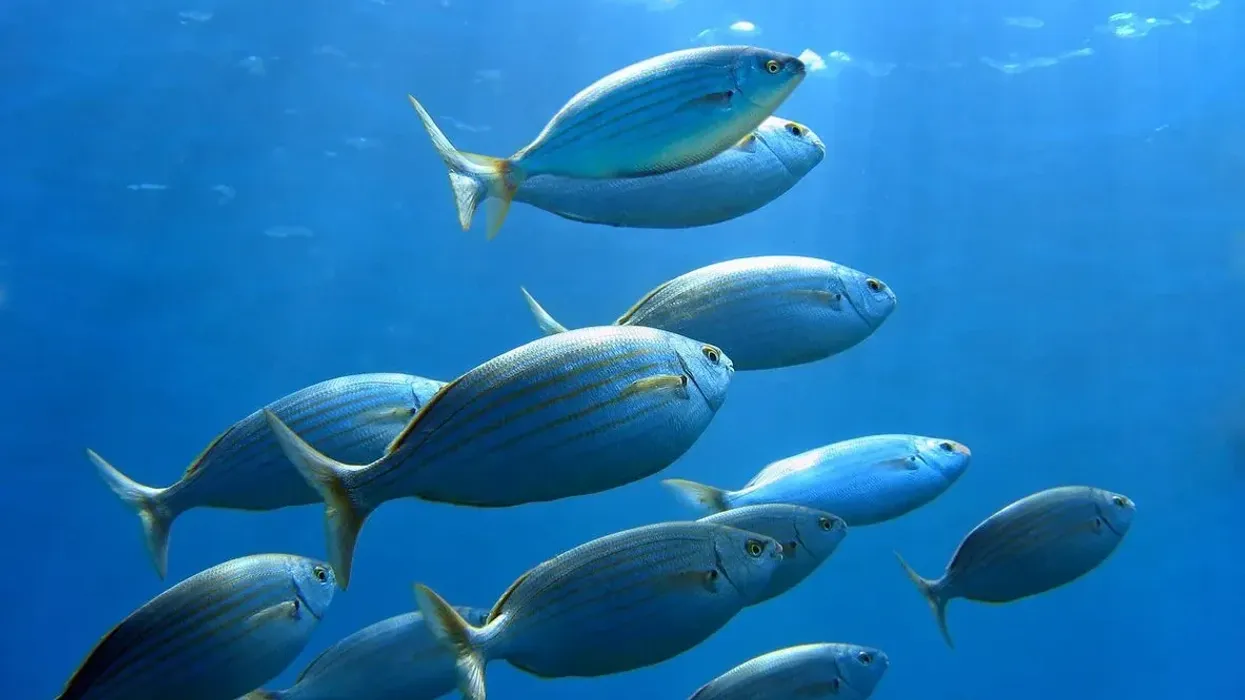The yellow-lipped sea krait (Laticauda colubrina) is an extremely venomous sea snake that belongs to the family Elapidae. It is also commonly known as the colubrine sea krait and the banded sea krait. This snake can be spotted in the tropical Indo-Pacific oceanic waters as well as on land.
The banded sea krait has a unique appearance. It possesses a black-colored head with a yellow-colored upper lip and snout.
The common name of this species is originated from its yellow upper lip and yellow snout. The upper side of the body of the banded sea krait is blue-gray-colored, and the bottom side is yellow in color and possesses broad scales.
The banded sea krait possesses a lethal venom that is neurotoxic. This venom is used to prey upon small fish as well as eels.
The banded sea krait often crosses paths with people as they tend to spend time on land to digest their food. Snakes of this species are not aggressive until attacked but they are highly venomous. Keep reading to discover more fun facts about the typical yellow-lipped sea krait habitat, distribution, breeding, and more great banded sea kraits facts!
If you enjoyed reading our yellow-lipped sea krait fun facts, you must check out our ssseriously cool Asian vine snake fun facts and redstripe ribbon snake interesting facts!
Yellow-lipped Sea Krait Interesting Facts
What type of animal is a yellow-lipped sea krait?
The yellow-lipped sea krait (Laticauda colubrina) is a highly venomous species of sea snake that belongs to the Elapidae family. Yellow-lipped sea krait venom is 10 times more venomous than the venom of the rattlesnake.
What class of animal does a yellow-lipped sea krait belong to?
These kraits of the Laticauda colubrina species belong to the class Reptilia.
How many yellow-lipped sea kraits are there in the world?
The total population size of these snakes is not yet evaluated. However, as per the IUCN, these snakes are abundant throughout their distribution range.
Where does a yellow-lipped sea krait live?
This sea snake is spotted in tropical Indo-Pacific oceanic waters as well as on land. It is present in stable numbers across the western Pacific Ocean and the eastern Indian Ocean.
As It has a natural affinity towards land, it is frequently found across India's eastern coasts and the Bay of Bengal's coast. It can also be seen in Myanmar and some regions of Southeast Asia from the Malay Archipelago towards Taiwan, the Ryukyu Islands of Japan, and southern China.
It is also commonly seen on the Pacific islands and Fiji. Some individuals of this species have also been reported to have strayed to New Zealand, New Caledonia, and Australia.
What is a yellow-lipped sea krait's habitat?
These yellow-lipped sea kraits have been observed dwelling in ocean waters, coral reefs, coral islands, mangrove areas, and shallow coastal waters. They also frequently choose land vegetation as a hiding site.
They can also be spotted beneath beach rocks, in caves, and in small crevices. Unlike true sea snakes that spend the majority of their life under the surface of the water, these sea kraits return to land to relax, reproduce and digest their food. They are also known to lay their eggs ashore.
Who do yellow-lipped sea kraits live with?
The yellow-lipped sea krait (Laticauda colubrina) is known to hunt and live on its own. However, it has also been observed to hunt within hunting parties of goatfish and giant trevally fish.
This hunting is referred to as cooperative hunting, and when it takes place, banded sea kraits dig out prey from holes and crevices, which are then consumed by the goatfish and the giant trevally!
How long does a yellow-lipped sea krait live?
The lifespan of these snakes of the Laticauda colubrina species is not yet known.
How do they reproduce?
Yellow-lipped sea kraits breed from September to December. Females of this species mate with more than one male in the same mating season.
Males have been observed to gather on land as well as in the water in areas that are slightly sloping. When a female is spotted by a male, she is chased by him, after which courtship commences.
Females are slower than males and are larger in size.
The female lays 10 eggs after mating and snakes of this species are oviparous, implying that they lay eggs that develop outside the female's body. These female sea snakes attain maturity at the age of one and a half to two and a half years, whereas male sea snakes attain maturity at one and a half years of age.
What is their conservation status?
The yellow-lipped sea krait (Laticauda colubrina) is classified as Least Concern by the IUCN's Red List as its numbers are stable.
Yellow-lipped Sea Krait Fun Facts
What do yellow-lipped sea kraits look like?
This species has a distinct appearance that looks quite symmetrical. It has a black-colored head that possesses lateral nostrils and it has a yellow-colored characteristic upper lip and snout.
The yellow color of the upper lip and snout stretches beyond each eye and the common name of this species is derived from its yellow upper lip and yellow snout. The dorsal side of the body of the banded sea krait is blue-gray in color, whereas the ventral side has broad scales and is yellow in color.
It possesses characteristic uniform width black rings across its entire length. These rings become narrow when they cross the belly.
Females of this krait species are larger than males. The tail is adapted to the swimming movement of this sea snake as it is paddle-shaped.

How cute are they?
This banded sea krait is not so adorable. It possesses a neurotoxic venom that can paralyze the muscles of a human being. However, they have a neat appearance as they have bands of the same width up to their belly. These bands become narrow as they reach the end of the tail.
How do they communicate?
These snakes communicate by hissing and through pheromones.
How big is a yellow-lipped sea krait?
The colubrine sea krait ranges between 34.4-55.9 in (87.5-142 cm) in length. This yellow-lipped sea krait size is half of that of the Gaboon viper!
How fast can a yellow-lipped sea krait move?
Adult males of this species are smaller than females and they can swim and crawl faster. They have adapted to their swimming needs and have a paddle-like tail. These snakes can move on land as well but at a slower speed than their speed in the water.
How much does a yellow-lipped sea krait weigh?
The banded sea krait weighs between the range of 1.3-3.9 lb (600-1,800 g).
What are their male and female names of the species?
Male and female snakes of this species do not have specific names.
What would you call a baby yellow-lipped sea krait?
A baby banded sea krait is called a hatchling
What do they eat?
These snakes are carnivores and they feed upon small fish and different species of eels. Adult females of this species forage in the deeper levels of the water to hunt conger eels. Males are smaller than females and thus hunt for smaller moray eels in the shallow water. They are preyed upon by larger fish such as sharks.
Are they poisonous?
Banded sea kraits are highly poisonous sea snakes. They do not bite or attack humans unless they are attacked or feel threatened, but their bite can kill a human.
Would they make a good pet?
No, banded sea kraits can't be good pets as they are dangerous creatures.
Did you know...
As banded sea kraits consume eels primarily, they indirectly control the eel population, playing an essential role in the ecosystem inhabited by them!
Do yellow-lipped sea kraits bite?
Yes, banded sea kraits can bite, but they usually utilize their toxic venom only to hunt small fish and eels. They aren't aggressive creatures and do not attack humans without cause.
Are yellow-lipped sea kraits slimy?
These sea snakes are not slimy. They are scaly and dry.
Here at Kidadl, we have carefully created lots of interesting family-friendly animal facts for everyone to discover! For more relatable content, check out these Indian krait surprising facts and banded sea krait interesting facts.
You can even occupy yourself at home by coloring in one of our free printable banded sea krait coloring pages.










